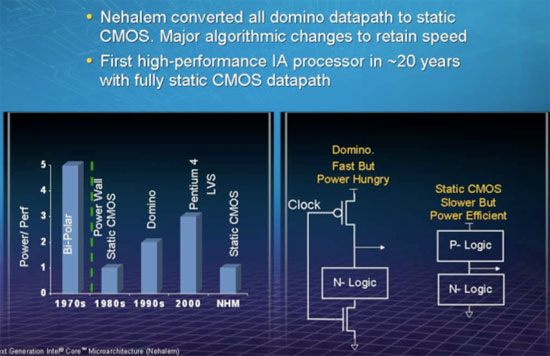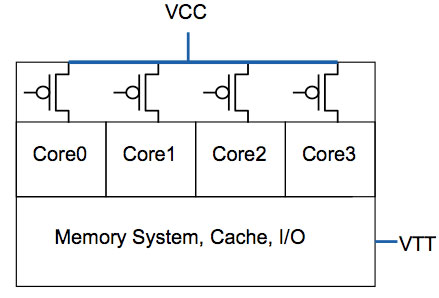Nehalem - Everything You Need to Know about Intel's New Architecture
by Anand Lal Shimpi on November 3, 2008 1:00 PM EST- Posted in
- CPUs
New Stuff: Power Management
At this year’s IDF the biggest Nehalem disclosures had to do with power management.
Nehalem’s design was actually changed on a fairly fundamental level compared to previous microprocessors. Dynamic domino logic was used extensively in microprocessors like the Pentium 4 and IBM’s Cell processor in order to drive clock speeds up. With Nehalem, Intel has removed all domino logic and moved back to an entirely static CMOS design.

Nehalem’s architects spent over 1 million transistors on including a microcontroller on-die called the Power Control Unit (PCU). That’s around the transistor budget of Intel’s 486 microprocessor, just spent on managing power. The PCU has its own embedded firmware and takes inputs on temperature, current, power and OS requests.

Each Nehalem core gets its own PLL, so each core can be clocked independently - much like AMD’s Phenom processor. Also like Phenom, each core runs off of the same core voltage - the difference between Nehalem and Phenom however is Intel’s use of integrated power gates.
Through close cooperation between Nehalem’s architects and Intel’s manufacturing engineers, Intel managed to manufacture a very particular material that could act as a power gate between the voltage source being fed to a core, and the core itself.


The benefit is that while still using a single power plane/core voltage, individual Nehalem cores can be completely (nearly) shut off when they are in deep sleep states. Currently in a multi-core CPU (AMD or Intel), all cores need to run at the same voltage, which means that leakage power on idle cores is still high just because there’s one or more active cores in the CPU.
Nehalem’s power gates allow one or more cores to be operating in an active state at a nominal voltage, while remaining idle cores can have power completely shut off to them - without resorting to multiple power planes, which would drive up motherboard costs and complexity.
The other benefit of doing this power management on-die is that the voltage ramp up/down time is significantly faster than conventional, off-die, methods. Fast voltage switching allows for more efficient power management.
I mentioned earlier that the PCU monitors OS performance state requests, so it can actually make intelligent decisions about what power/performance state to go into, despite what the OS is telling it. There are some situations where Vista (or any other OS) running an application with a high level of interrupts will keep telling the CPU to go into a low power idle state, only to wake it up very shortly thereafter. Nehalem’s PCU can monitor for these sorts of situations and attempt to more intelligently decide what power/performance states it will instruct the CPU to go into, regardless of what the OS thinks it wants.










35 Comments
View All Comments
defter - Friday, August 22, 2008 - link
Links are 20-bit wide, regardless of encoding or whether 1,2,8,16 or 20 bits are used to tranmist the data.I wonder who is flamebaiting here, a previous poster just mentioned the correct link width, he wasn't talking about "usable speed".
rbadger - Thursday, August 21, 2008 - link
"Each QPI link is bi-directional supporting 6.4 GT/s per link. Each link is 2-bytes wide..."This is actually incorrect. Each link is 20 bits wide, not 16 (2 bytes). This information is on the slide posted directly below the paragraph.
JarredWalton - Thursday, August 21, 2008 - link
It's 20-bits but using a standard 8/10 encoding mechanism, so of the 20 bits only 16 are used to transmit data and the other four bits are (I believe) for clock signaling and/or error correction. It's the same thing we see with SATA and HyperTransport.ltcommanderdata - Thursday, August 21, 2008 - link
Since the PCU has a firmware, I wonder if it will be updatable? It would be useful if lessons learn in the power management logic of later steppings and in Westmere can be brought back to all Nehalems through a firmware update for lower power consumption or even better performance with better Turbo mode application. Although a failed or corrupt firmware update on a CPU could be very problematic.wingless - Thursday, August 21, 2008 - link
I thought about this when I read about it the first time too. Flashing your CPU could kill the power management or the whole CPU in one fell swoop!